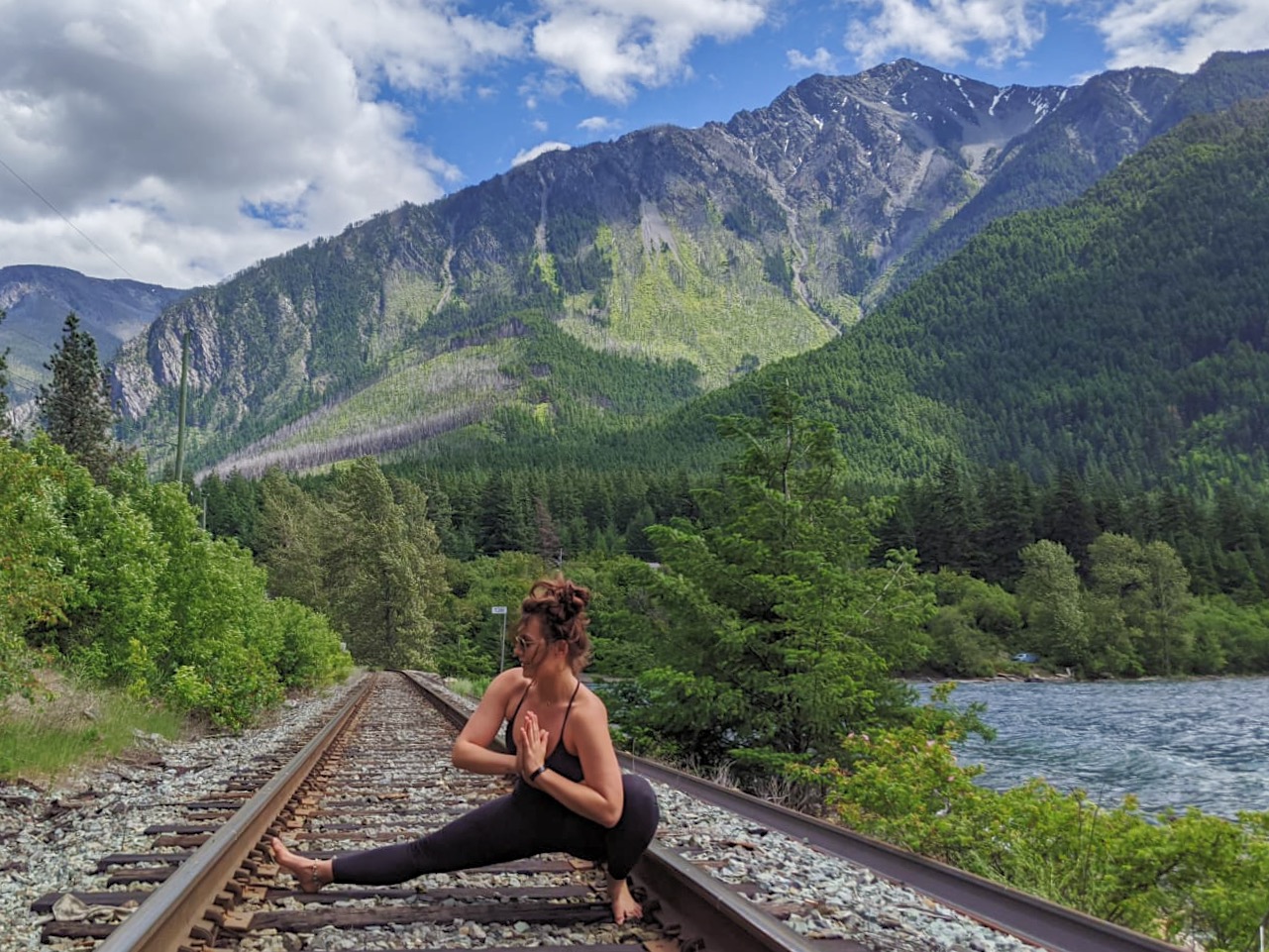Written by: Charlotte Gravert, SFU Student
I vividly remember the first time I went to a yoga class — the kind of yoga that contemporary pop culture treats as the image of youth, answer to good health, and the quick fix for all kinds of humanitarian ailments. Picture skin-tight leggings on slender flexible white women under 40 popping into downward dogs in their lunch breaks from their corporate jobs. I only learned deep into my yoga journey that yoga can be much more.
The studio was conveniently located in downtown Toronto, had a small coffee shop in the front, and a shiny washroom with product placements in the back. I was awkwardly sitting on my yoga mat in the midst of girls warming up their splits, regretting I didn’t show up earlier to catch a spot in the back. Going through the poses, all I could think about was my sweat dripping on the mat. It turned my already gripless mat into a water slide that I feared wouldn’t be a soft landing for my face when my hands decided to fly off the edge. To make things worse, not a single mat around me showed the same scattered sweat stains.
Despite the fact that I hated being in this first class, I kept coming back. Locked in by the imminent promise of achieving what the other girls had and armed with an overpriced yoga mat, a new outfit, and a safe spot in the back, I pushed through sun salutation after sun salutation. On the surface, I was getting stronger and more comfortable but beneath, I felt as if I was continuously falling short.
Thanks to the yoga community I had immersed myself in, I was never short on new products and practices to fix myself with. In the yoga studio, as well as online, I had teachers and fellow students who were never short of recommendations. With each purchase, I was getting a little closer to the promised yogaland, a place where everyone is beautiful and healthy! With each investment into my future self, I was becoming a more authentic version of myself.
Or that’s what I thought. It took me years to realize that wasn’t necessarily the case.
My toxic on-off relationship with yoga became habitual. Whenever I didn’t practice for a while, whenever I didn’t make it all the way through the 30 Day Challenges, I always found a new thing to buy myself new credibility with. The mantras of the classes fueled my self-obsession: “Thank yourself for showing up on your mat today, for making this time for yourself.”
It wasn’t until one lucky day in the midst of lockdown, that the stars of academia, life, and yoga aligned.
I never had the money to spend on a full yoga teacher training (we’re talking at least $2,000) but I always had an eye on it — the ultimate self-investment. During the lockdown, Yoga Alliance allowed for yoga teacher training to be held online, and many of them were much cheaper than the in-person retreats. I looked for about a month before deciding on a training that felt authentic, despite the site design looking a bit rough. Honestly though, I couldn’t argue with the $300 price tag.
At the same time, I was doing a directed study about the culture of neoliberalism to complete my MA coursework. While reading into the sociological effects of late stage capitalism — in particular how we turn ourselves into enterprises in constant competition with one another and are stuck in a never-ending pursuit of becoming better, faster, and stronger — something clicked. I wasn’t practicing yoga at all. I was practicing neoliberal self-discipline, using yoga as a vehicle for the ideology that is currently destroying our planet.
It was through my Master’s degree that I finally found a yoga practice that truly served me, and in some way, my environment too. Creating a practice that wasn’t only about myself, but one that shifted to focus on a better together. I was no longer faking a good conscience through acts of consumer activism, but instead taking up the work to protest the things brands falsely made me believe were being fixed through my purchases. The way I practice yoga now differs immensely from the workouts I previously put myself through. Now, when I practice yoga, I practice listening — listening more carefully and moving more intently.
Yoga is a diverse practice with its philosophical roots dating back 1000s of years to India. But yoga’s multivalent forms are currently under attack by one dominant neoliberal ideology. Yoga is commercialised, stripped of all cultural heritages, and utilised as a tool for people to cope rather than react to late capitalism. Whatever kind of yoga you practice, it is important to check your alignment, not just physically, but also ideologically. For me, this meant taking my practice and yoga teacher training not as an opportunity for personal gain, but as an opportunity for education. Education as a tool for true empowerment, breaking free from the fake positivity and toxicity sold under the “yoga” label.
Not falling for the toxicity in today’s yoga culture means not supporting the blunt ableism, ageism, racism, and sexism. It means creating a yoga culture where teachers are paid living wages and the practice is accessible. Where BIPOC and LGTBQ+ practitioners are heard and have the same platform as heteronormative white yogis. Yoga has become a site of gentrification and gatekeeping, and it is up to all of us, to practice what we preach and hold space for one another in a system that is largely failing us.
One step at a time. Today, this might look like listening to the amazing podcast by Tejal Patel and Jesal Parikh Yoga is Dead. Or choosing your next YouTube yoga class from a BIPOC teacher.


[…] Source link […]
[…] Source link […]